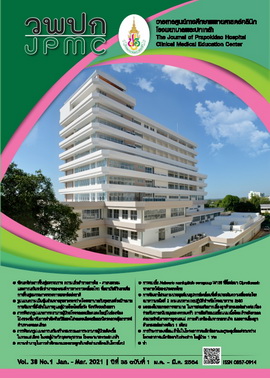The Development of Nursing Care Model for Patients with Abdominal Aortic Aneurysm Undergoing Endovascular Aneurysm Repair
Main Article Content
Abstract
BACKGROUND: Endovascular aneurysm repair (EVAR) for patients with abdominal aortic aneurysm (AAA) requires a specialized surgical team. Apparently, the existing nursing care model is only a guideline for the care of patients undergoing general surgery. Consequently, the researchers developed the EVAR nursing care model. Implementing evidence-based practice that is accurate, up to date, and suitable for the context of surgery in Thailand is necessary. The EVAR care model can help reduce the mortality and morbidity rate, thereby enhancing quality of life for patients with AAA.
OBJECTIVES: This action research aimed to develop the nursing care model for patients undergoing EVAR, and study the effects of the EVAR care model on nursing outcomes.
METHODS: This study was divided into 2 phases including Phase 1: Development of the EVAR nursing care model using IOWA model, and Phase 2: Use of the EVAR care model. The samples comprised of health personnel involved in EVAR surgery. Fifty AAA patients undergoing EVAR matched pair by age and gender and then were divided equally into 2 groups (comparison & experimental groups). The research instruments consisted of a group discussion form, a behavior observation form for surgical personnel, the EVAR care model, a patient data recording form, a satisfaction assessment form surgical failure (SF) record as measured by its complications, duration of surgery (DS) and cost of surgery (CS) record, and post-operative length of stay record (P-LOS). Data were analyzed using descriptive statistics, Chi-square, and independent t-test.
RESULTS: The findings showed that the EVAR care model yielded overall quality at 76.4 %. Therefore, it met the standard for model quality (greater than 60%). 86.7% of the operating staff expressed satisfaction with the model’s application at the highest level. In addition, there were no statistically significant differences in SF, DS, or P-LOS for both groups. There was statistically significant different in CS between both groups (t = 2.28, p < 0.05).
CONCLUSIONS: The EVAR care model is an innovation for care focusing on healthcare outcomes. Broad implementation of the EVAR care model and monitoring of its effectiveness to promote quality of care are recommended. A longitudinal study focused on potential complications is also recommended.
Article Details
References
Tinkham MR. The endovascular approach to abdominal aortic aneurysm repair. AORN J 2009; 89:289-302
Collin N, Haslam E, Fay D, Hardman J, Horrocks M. A review of endovascular management of abdominal aortic aneurysm. Br J Hosp Med (Lond) 2009;70:146-50.
Maharat Nakhon Ratchasima Hospital. 2018 Annual report. Nakhon Ratchasima: Maharat Nakhon Ratchasima Hospital; 2018.
Ministry of Public Health. List of high cost surgery. Bangkok: Department of Medical Services; 2013.
Lederle FA, Freischlag JA, Kyriakides TC, Padberg FT Jr, Matsumura JS, Kohler TR, et al. Outcomes following endovascular vs open repair of abdominal aortic aneurysm: a randomized trial. JAMA 2009;302:1535-42.
Collaborative IM, Buckwalter KC, Cullen L, Hanrahan K, Kleiber C, et al. Iowa model of evidence-based practice: revisions and validation. Worldviews Evid Based Nurs 2017; 14: 175-182.
Kemmis S, Mc Taggart R, Nixon R. Introducing critical participatory action research. In S Kemmis, R Mc Taggart, R Nixon. (Eds.), The action research planner: Doing critical participatory action research. Singapore: Springer; 2014. pp. 1-32.
Melnyk BM, Fineout-Overholt E. Evidence-based practice in nursing & healthcare. A guide to best practice. 3rded.Philadelphia: Wolters Kluwer; 2015.
Srisatidnarakul B. The methodology in nursing research. Bangkok: U & I Intermedia Co.Ltd.; 2010.
Brouwers M, Kho ME, Browman GP, Cluzeau F, feder G, Fervers B, Hanna S, Makarski J. on behalf of the AGREE Next Steps Consortium. AGREE II: Advancing guideline development, reporting and evaluation in healthcare. Can Med Assoc J. Dec 2010, 182:E839-842; doi: 10.1503/cmaj.090449.
Wongwatanarerk W, Thipayarak A, Hotakasapkul K, Chiaranai C, Chularee S. Manual of nursing care model for patients with abdominal aortic aneurysm undergoing endovascular aneurysm repair. Nakhon Ratchasima: Maharat Nakhon Ratchasima Hospital; 2019.
McGinty J, Anderson G. Predictors of physician compliance with American Heart Association guidelines for acute myocardial infarction. Crit Care Nurs Q 2008; 31:161-72.
Melnyk BM, Fineout-Overholt E, Gallagher-Ford L, Kaplan L. The state of evidence-based practice in US nurses: critical implications for nurse leaders and educators. J Nurs Adm 2012;42:410-7.
Li B, Khan S, Salata K, Hussain MA, de Mestral C, Greco E, Aljabri BA, et al. A systematic review and meta-analysis of the long-term outcomes of endovascular versus open repair of abdominal aortic aneurysm. J Vasc Surg 2019; 70(3): 954-69.
Mehaffey JH, LaPar DJ, Tracci MC, Cherry KJ, Kern JA, Upchurch GR Jr. Targets to prevent prolonged length of stay after endovascular aortic repair. J Vasc Surg 2015;62:1413-20.
Gavali H, Mani K, Tegler G, Kawati R, Covaciu L, Wanhainen A. Editor's choice - prolonged ICU length of stay after AAA repair: analysis of Time Trends and Long-term Outcome. Eur J Vasc Endovasc Surg 2017;54:157-63

